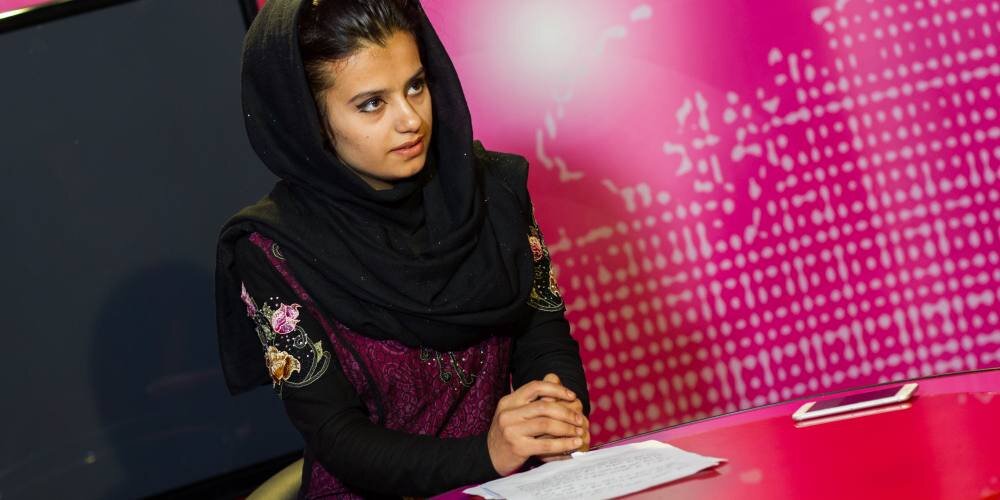Women are taking charge of newsrooms in Afghanistan so they can finally tell their own stories.
Mahdia Rasa, an anchor for Zan TV, sits behind her desk in the world news studio. Photo: Ivan Flores.
Mahdia Rasa knew from a young age that she wanted to be a journalist. During her childhood in Afghanistan, she had seen foreign reporters flock there to tell the story of her homeland as troops reclaimed her country from the clutches of the Taliban. “But there is so much more to tell, and I wanted to be the one to tell it,” the 21-year-old says.
Yet she faced a deeply conservative society in which many would prefer women to stick to defined gender roles. She recalls long arguments at home after announcing her decision to pursue journalism.
“But this is what I had wanted and I wasn’t going to allow anyone to come in the way of my dreams,” Rasa says. And for the past year, she has been working as a news presenter at Zan TV, a television station run in large part by Afghan women.
But female journalists like Rasa don’t just face challenges from their families. “Apart from the usual security issues, being a woman creates additional challenges for us in journalism, and you can’t always find the support you need from co-workers,” says Freshta Mahori, who has been working in the Afghan media industry for nearly five years.
Zan TV
In response, several women-only newsrooms have recently sprung up. Zan TV is one broadcast network that not only employs female journalists but also caters to a largely female audience.
“We wanted to give women the space they need to tell their stories,” says Hamid Samar, who founded the station in early 2017. ‘Zan’ in Dari, one of Afghanistan’s national languages, means ‘woman’. For Samar, Zan TV was more than a business opportunity in an untapped industry; he sees the venture as a way to further the cause of women’s empowerment in Afghanistan.
In a strictly gender-segregated society such as Afghanistan, male journalists have little or no access to the female sources, resulting in incomplete narratives.
In a strictly gender-segregated society such as Afghanistan, male journalists have little or no access to the female sources, resulting in incomplete narratives. In turn, increased participation of women in media helps amplify women’s voices in public.
The satellite channel broadcasts 14 news and entertainment shows and Samar says it is already attracting hundreds of thousands of viewers. Of the 78 staff members at the Kabul office, 54 are women while the editorial management team is entirely women-led. They are paid salaries in accordance with industry standards and on par with male colleagues.
“What I like about working for Zan is the female-friendly space it has created for its employees. Almost everyone here is a woman and is focused on supporting women which makes it easier,” says Mahori, now a producer for Zan TV.
Her 20-year-old camera operator, who gave her name only as Mary, adds that many people have told her she should not be doing “a man’s job”. “Just by being here today, doing what I am doing, I am proving them all wrong,” she says.
Mary, a 20-year-old camera operator at Zan TV, checks the settings on her video camera. Photo: Ivan Flores.
But employing a mostly female workforce and focusing coverage on politics and women’s empowerment has brought its own set of challenges, with some men claiming Zan TV is destroying families by promoting gender equality.
“While there has been a lot of support, we have also received a lot of threats from those who disapprove of what we do here. In the very first month, we received several angry messages from people who threatened to wage jihad against this TV station,” says Samar.
Zan TV is part of a growing movement that encourages Afghan women to work in the media. A similar venture, a women’s lifestyle magazine called Gellara, sold 2,000 copies of its launch edition in May. And Mirman Radio broadcasts its female-focused content across the far dusty corners of Kandahar province in the local language of Pashto. With a largely female editorial board, the station airs daily talk shows on women’s rights, and listeners call in from as far afield as villages across the border in Pakistan.
Radio Shaista
Another women’s station, Radio Shaista, has been broadcasting in the fragile northern province of Kunduz, which has already fallen to Taliban twice in the past two years. Despite looming threats, staff continue to run the station, intermittently, whenever the Taliban isn’t around.
As the security situation in Afghanistan deteriorates, journalists are facing threats and even violence for their work. Last year was documented as the bloodiest on record, with more than 13 Afghan journalists killed.
In this environment, women journalists find themselves vulnerable to harassment and intimidation.
“Afghans also tend to assume that women won’t be able to handle the sensitive security situation. This, along with the conservative nature of society, often leads families to refuse permission to women from being journalists,” Rasa says.
“But being in an all-woman environment, run and managed entirely by women, makes it easier for many of us to work [free from] the pressures of society.”


